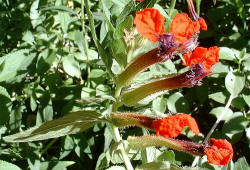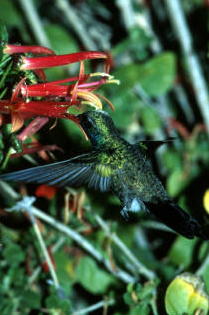Migratory Pollinators Program
RUFOUS HUMMINGBIRDS
Predicting Spring (Northward) Nectar Corridors
The migratory corridors through Sonora appear to be delineated by the phenology and geographic distribution of the most-visited flowering plants. These nectar resources have well defined seasonal and geographic distributions. The tree morning glory is the only obvious plant with nectar available in January and February that occurs continuously along the tropical coast of Mexico. From Nayarit to southern Sonora, its distribution follows the Sierra Madre Occidental, which edges the tropical lowlands into a narrow ribbon. In southern Sonora near the Sinaloa border (26º30'N), the coast becomes broader (the tropical zone between the Sierra and the Sea of Cortez). On the coastal plain, rainfall gradually decreases northward through the transition from coastal thornscrub to the Sonoran Desert near Guaymas (27º30'N; Turner and Brown 1982). Northward bound rufous hummingbirds could potentially use one or more of three floral corridors (Map 8).
Foothills Corridor: The Foothills Corridor is east of the Sonoran Desert and passes through tropical deciduous forest and taller foothills thornscrub as far north as the Río Yaqui near Tónichi (28°34'N). This corridor largely follows the Río Mayo and Río Yaqui valleys northward until they veer eastward toward their headwaters in the barrancas in the Sierra Madre Occidental in Chihuahua. Tree ocotillos are common in thornscrub in the lowlands near the rivers while tree morning glories become common on the tropical slopes above. Both are locally common in patches almost to the United States border in north-south river valleys of the Río Sonora (30°11'N)/Río Moctezuma and Río Fronteras/Río Bavispe (northern tributaries of the Río Yaqui).
Plains of Sonora Corridor: The Plains of Sonora Corridor passes through the Plains of Sonora subdivision of the Sonoran Desert through Hermosillo (29°05'N) to Santa Ana (30°N). From south to north, spring flowers are dependable on ocotillos, palo adán, and tree ocotillo, as well as tree morning glories on emergent thornscrub-clad desert ranges. Rufous hummingbirds are regularly encountered from early March to early April in the Sonoran Desert north of Hermosillo in central Sonora, in the Pinacate Region of northwestern Sonora (Calder 1993), and in the Lower Colorado River Valley in southwestern Arizona and adjacent California (Rosenberg et al. 1991; Lin Piest, pers. comm. 2001).
Gulf Coast Corridor Rufous hummingbirds using the Gulf Coast Corridor follow the coast through the Sonoran Desert to northwestern Sonora feeding on palo adán, chuparrosa, and ocotillo. The Central Gulf Coast subdivision of the Sonoran Desert is similar on both sides of the Sea of Cortez, and hummingbirds could fly across the Gulf of California and continue northward through Baja California. Observations of rufous hummingbirds on Tiburón, San Esteban, San Lorenzo Sur, and Ángel de la Guarda islands (Cody 1983) suggest that some of the birds utilizing the Gulf Coast Corridor island hop across the Sea of Cortez to continue north along the east coast of the Baja Peninsula.
 |
|
Dense
stands of ocotillo (seen here in leaf) are important food resources for hummingbirds.
Tucson Mountains, Arizona. |
Tree morning glories and tree ocotillos, found along the Foothills Corridor and the Plains of Sonora Corridor, provide the most dependable flowers each year. The northern end of the Foothills Corridor in the upper Río Sonora Valley is too far east for most hummingbirds migrating to California. However, some rufous hummingbirds are seen in the spring in southeastern Arizona in unusual years like 2001. Chuparrosa, palo adán, and ocotillo on the Gulf Coast Corridor respond to variable winter-spring rainfall from Pacific frontal storms and, thus, are less dependable floral resources. Our observations suggest that all three nectar corridors were used in 2000 and 2001, but to varying degrees depending upon where rainfall from the previous season had generated the greatest floral abundances.
Predicting Summer (Southward) Nectar Corridors
In summer, the rufous hummingbird migratory corridors are not so obvious. On a large scale, two main flyways are used for the southbound return from the Pacific Northwest to Mexico, one by way of the Sierra Nevada and coastal ranges, and the other following the Rocky Mountains southward to Mexico. These birds exhibit route fidelity modified only in elevation as necessary to exploit annual variation in phenology of nectar sources for refueling (Calder 1987).
 |
Castilleja
patriotica |
On a smaller scale, the details
of the southerly migration in the southern U.S. and in Mexico are not well understood,
but rufous hummingbirds are known to fly along the Sierra Madre Occidental and
Oriental at high elevations. We also know that some rufous hummingbirds
are traveling through the Sonoran Desert in the late summer/early fall even though
there are fewer large patches of hummingbird-attracting flowers in the Sonoran
Desert than in adjacent uplands during this time. We do not know if they
are moving from one mountain island to another or if they are relying on feeders
and smaller patches of resources in the desert for refueling. Some of these
migrators are using north-south riparian corridors while others have been observed
traveling through open desert. During late summer, large patches of plants
in flower and the hummingbirds attracted to them are more common in oak woodland
and pine-oak forest in the Sierra Madre Occidental. In thornscrub and tropical
deciduous forest, a number of vines, including queen's wreath/sanmiguelito (Antigonon
leptopus) and various morning glories/trompillos (Merremia palmeri,
Operculina pteripes, Ipomoea sp., Jacquemontia sp., and Schizocarpum
palmeri) have showy flowers. Hummingbirds likely are visiting these
last two though we have no observations to confirm this.
 |
Cuphea
llavea |
Above tropical deciduous forest in the Sierra Madre Occidental, summer floral abundance increases dramatically. Hierba del piojo is the most common flowering shrub in oak woodland that attracts hummingbirds in July and August. In pine-oak forest, hummingbirds concentrate in local dense patches where reddish flowers occur including cardinal flower (Lobelia cardinalis), India (Zinnia peruviana), Indian paintbrushes/periquito (Castilleja patriotica, C. teniflora),
Maycoba sage, pineapple
sage, and Texas betony. In early September 2001, rufous hummingbirds were
aggressively defending territories in dense Indian paintbrush and Texas betony
patches in the pine-oak forest zone at 2100 m on Mesa del Campanero. Six
to ten other species of hummingbirds were also present.
 |
Lobelia
cardinalis |
In summer in the Sierra Madre Occidental, hummingbirds are also likely visiting a diverse group of plant species that do not occur in dense patches (e.g. Agastache mearnsii, bat-faced monkeyflower/perrito colorado (Cuphea llavea), beardtongues (Penstemon campanulatus, P. wislizenii), cigarrito (Bouvardia ternifolia), Lamourouxia viscosa, Madrean starthistle/cardo (Centaurea rothrockii), other sages (Salvia betulaefolia, S. townsendii, S. microphylla), and others).
The two Penstemon species and the latter Salvia species listed above have no prior hummingbird visitation observations, but are likely utilized by hummingbirds. Many other plant species are likely visited by hummingbirds, but have not as of yet had confirmed observations and so are not included in the plant tables in this report. During summer, it is difficult to observe hummingbirds feeding at the species listed above because both the flowers and birds are more dispersed, and the nectar resources may not be sufficient for hummingbirds to establish territories. It is unlikely that these plant species alone provide adequate stopover habitats for rufous hummingbirds since they are so widely scattered.
CONCLUSIONS
Migration Corridors
-
There are three potential nectar corridors for rufous hummingbirds during the northbound spring migration:
- Foothills Corridor: Follows tropical deciduous forest and foothills
thornscrub between the Sonoran Desert and the Sierra Madre Occidental north to
the United States.
- Plains of Sonora Corridor: Goes through
the Sonoran Desert from Guaymas through Hermosillo to Santa Ana.
- Gulf Coast Corridor: Follows the coast to northwestern Sonora, or crosses the Sea of Cortez to Baja California using the midriff islands (Tiburón, San Esteban, San Lorenzo Sur, and Ángel de la Guarda islands) as stopovers
- Foothills Corridor: Follows tropical deciduous forest and foothills
thornscrub between the Sonoran Desert and the Sierra Madre Occidental north to
the United States.
- Southward migration routes are not as well understood. Two main flyways are used to return south from Canada and Alaska, one by way of the Sierra Nevadas and coastal ranges and the other by way of the Rocky Mountains. The routes are less clear as they approach the U.S./Mexico border. Once in Mexico, rufous are known to travel across the desert, but many are following the higher elevations of the Sierra Madre Occidental as well. It is not known what percentage of the migrators uses the eastern vs. western slopes of this mountain range.
-
Tree morning glories and tree ocotillos (common on both the Foothills and Plains of Sonora Corridors) provide the most dependable flowers each year.
-
Chuparrosa, palo adán, and ocotillo on the Gulf Coast Corridor respond to variable winter-spring rainfall from Pacific frontal storms and, thus, are less dependable floral resources.
-
Observations suggest that all three nectar corridors are used, but to varying degrees depending upon where rainfall from the previous season generates the greatest floral abundances.
-
Nine areas with important populations of nectar plants used by rufous hummingbirds and other species that warrant protection were identified
(Table 8).












